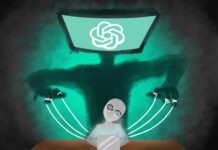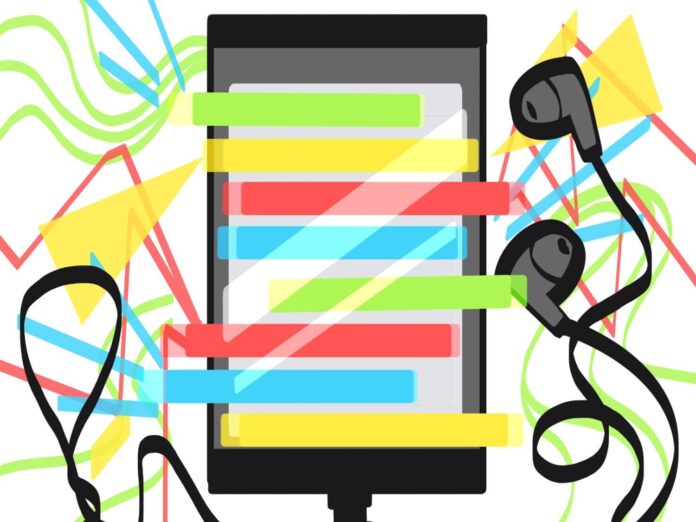People say that a cluttered desk means a cluttered mind. But what about a cluttered playlist? I don’t mean a playlist with twists and turns, ups and downs or eclectic vibes, but one that lacks all clarity or a loosely connecting theme. That is, a playlist of entire music libraries (Baby Shark, Ave Maria and all) thrown into one long, amorphous blob of cacophony — what I dub the “demon playlist.” I believe that this is not just a harmless trend, but symbolic of a deeper problem within our generation.
I first experienced the throes of a “demon playlist” a few weeks ago while on the way to Target with my friend. Out of respect for him offering to drive, I let him control the speakers, but quickly realized his playlist had no interlinking theme. It was about as uniform as a ransom note cut out of a bunch of magazine strips. From “i remember” by bbno$ to “Firework” by Katy Perry to “Abracadabra” by Steve Miller Band, it felt like I was on a musical roller coaster with malfunctioning safety bars. I realized that my friend is not a red herring; since talking with others, I found that most people have that “one” playlist with every song they have accumulated from birth until present.
People’s music listening behaviors are in a strange place. You could argue that listening to a disordered playlist is like listening to a radio station, but even those have a unifying theme: genre, decade, locality, etc. Moreover, radio stations often introduce each song, providing context for the listening experience. With demon playlists, there are no buffers or transitions, but instead quick jolts from one song to the next — from the twang of a guitar to the banging of a steel drum to the buzz of an electronica song.
I cannot blame my peers for their “demon playlists” without acknowledging that playlist building is not everyone’s forte. But why is that so? One reason is that not everybody cares. Playlists take time to create, and they require a sufficient number of songs in our library to begin with. However, this does not prevent anyone from listening to curated playlists offered through every music streaming service. Most likely, people have lost the desire to listen to cohesive playlists, just like they have with albums.
We live in the age of short-form content. Apps like TikTok and YouTube Shorts have captured the attention spans of Gen Z, reducing them to mere seconds. People are not only being conditioned to consume short-form content but also to abrupt shifts in the types of content they receive. If people are used to scrolling from a cute cat video to a DIY makeup video or a video of a bloody war, they will seek similar variety in their playlists. Sometimes, they will skip through songs midway because they lose interest; at that point, even a playlist with variety and zing cannot compensate for people’s abbreviated attention spans.
Shortened attention spans are not the only culprit. While people’s increased accessibility to music has broadened music tastes and garnered support for smaller artists, it has also led to a desensitization to music. As amazing as it is that I can listen to virtually any song that exists, it has made me more apathetic to the basic experience of listening to music. To chase that high of novelty and excitement, it only makes sense that people are concocting the most obnoxious mixtures of songs with apt titles such as “404 not found” and “my cats torture me.”
Social contagion might also be influencing the degeneration of playlists. Friends tend to copy friends, and if my friend makes playlists with incoherent song mixtures, perhaps I will too. This doesn’t mean that everyone is participating in “demon playlist” culture, but it does mean that disordered playlists will soon become the norm, with anything else being considered passé. I can already hear the dismissive remarks in my mind: “Wow, your playlist is only 20 songs? And they all sound vaguely similar? They have a loosely connecting theme? That’s so last year, man.”
As I grumble about this perplexing trend, I have to accept that some of you will continue creating your treasured “demon playlists.” However, by listening to music in such an ad-hoc way, you are further desensitizing yourselves to the beauty of music. Listening to music is a sacred experience — it can bring you back to different times in your life or transform you to new and wonderful places. But this only works when you listen to music in a structured way.
“When You Wish Upon a Star” is a beautiful song and one that reminds me of my childhood (I’m not 92… I just love Disney). But if I were to throw that classic into a playlist with “Call Me Maybe” and “Fireball,” it would lose its appeal. That is no slight on the latter two songs, but a recognition that all three songs deserve a different playlist to call home. Let’s not let our playlists devolve any further. If you are struggling to make coherent playlists, there are resources out there that can help. In the words of Michael Jackson, “You are not alone.”
Contact Nick Dobbs at ndobbs@oxy.edu
![]()



































